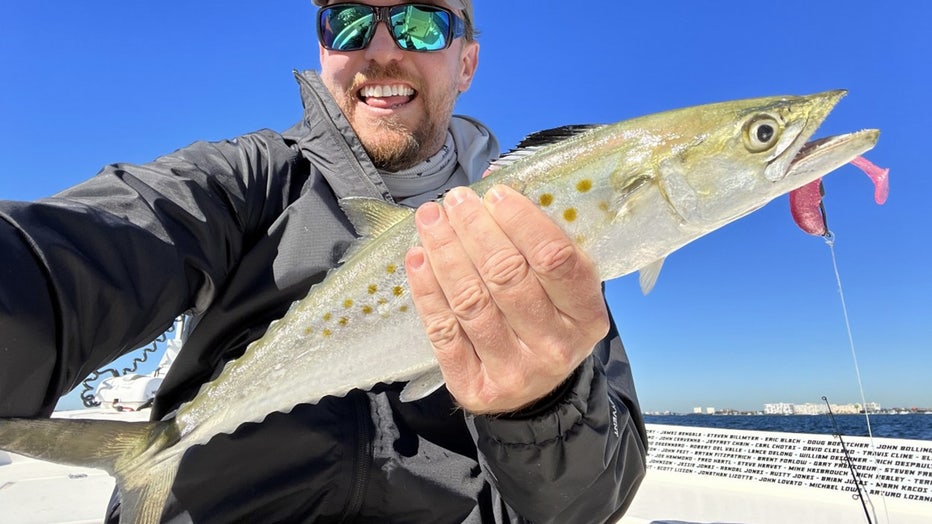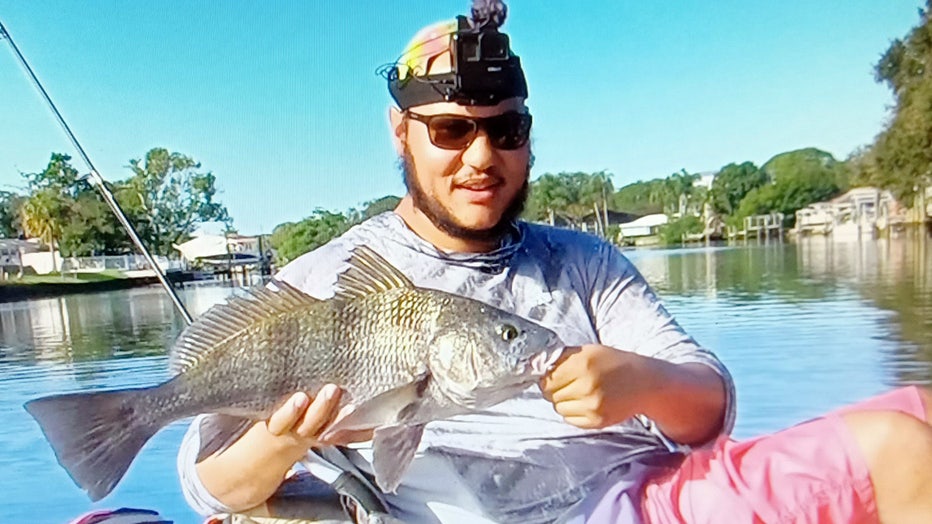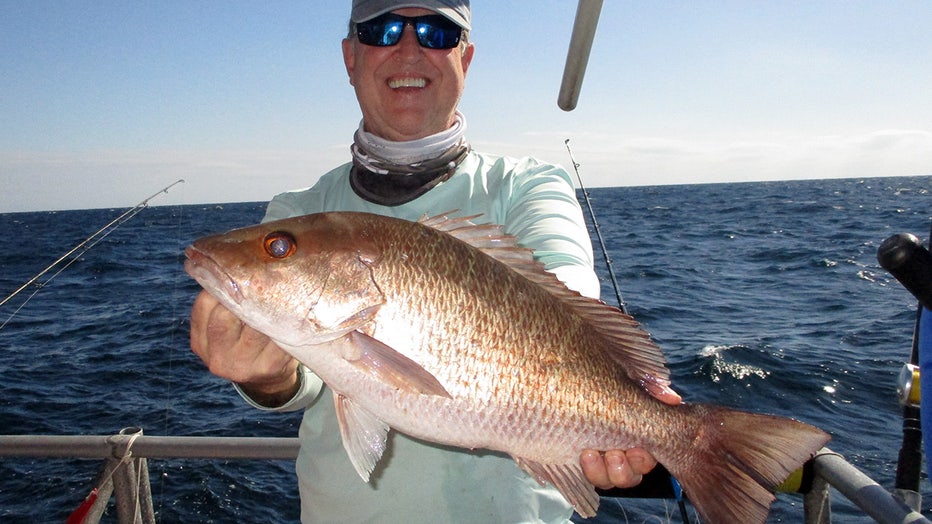Fishing Report: Nov. 19, 2021

Cold snap may push fish out of passes and off beaches
Snook action has been going well still around our passes and even some on the beaches while many fish start moving to the back bay. Gag grouper action continues to pick up slowly around the near-shore waters adjacent to our coastline, says Captain Dylan Hubbard of Hubbard?s Marina.
MADEIRA BEACH, Fla. - Every Friday morning, Captain Dylan Hubbard of Hubbard's Marina joins Good Day to fill viewers in on his fishing forecast as we head into the weekend.
Here is his fishing report for November 19, 2021.
Yet another week without red tide in the forecast for our area is something to celebrate! However, we are not going to sit complacent until another bloom comes.
We are working with Capt Planet’s eco preservation project to raise funds and procure and place artificial reefs around our area to ‘soften’ the coastline and provide more filtration for our marine eco system with the help of Tampa Bay fishing outfitters and we are going to work with our partners to hopefully raise more funds to get even more reefs installed after our initial project gets installed early December! Stay tuned for more information on that project, and also, here is the latest forecast and levels from the USF and FWC collaborative efforts: http://ocgweb.marine.usf.edu/tbm/hab/
Inshore
Snook action has been going well still around our passes and even some on the beaches while many fish start moving to the back bay. We have a very cold week ahead with some big fronts in the lineup which will help to continue to push the fish out of the passes and off the beaches to a more wintertime pattern of staging in the back bays around river, creek, and bayou mouths plus also around residential dock lines in those back bay dark mud canals.
For now, target those snook around the structures where water is moving and bait is present and look for the points, pockets, or choke points like passes or areas where fish can stage and let the bait come to them without expending much energy. Then once you find the fish, make sure you are presenting your bait naturally and working your lure with the current to ensure it appears naturally and gives you the best opportunity for the fish to bite!
Redfish have been doing well, too, but are getting a little more spread out and harder to find large concentrations. However, with some effort you can find them following schools of mullet or bait fish around the flats, mangroves, or oyster bars.
We are on a full moon right now so that is going to provide for plenty of moving current to get the fish feeding more through the weekend, plus with the full moon low tides you have the opportunity to explore the area you typically fish to find the potholes and cuts that will concentrate the fish at lower tides. At the full moon higher tides, look for the fish around the mangrove shore lines or those oyster bars that are normally extremely shallow or nearly out of the water as the fish use the higher tides to scavenge these areas for the plentiful crustaceans that have proliferated with the red tide blooms as of late. We are seeing larger shrimp and more and more crabs than ever.

Mackerel (Credit: Hubbard's Marina)
Trout action has been a little soft, but we are seeing some very large trout when they are caught. We are seeing some nice trout around the dock lights and bridge lights near the passes where water is moving and there’s bait present. Also, around those edges of the grass flats and the potholes and cuts adjacent to the flats are good areas to look as well. Plus, around the docks adjacent to the flats or areas holding bait is a good area to look for trout as well.
Sheepshead action is heating up well as the waters continue to cool off. We are seeing bigger and bigger concentrations of sheepshead around our dock lines, bridges, jetties and seawalls and we are not far from the big schools of sheepshead amassing around our local rock piles as they prepare for the near shore migrations to spawn.
Black drum are biting well too around docks, bridges, and the mangroves too. Look for them using live shrimp, small crabs or slow moving soft plastics in these areas they frequent. Especially large dock structures or bridges are good areas to find the black drum and while sheepshead fishing you will often run across these black drum too.

Black drum (Credit: Hubbard's Marina)
Jack crevalle are prolific around the area right now we are seeing quite a few of these fish moving around the bay. Look for birds feeding at the edges of the flats or around the bridges or passes. These guys will give away big areas of bait schools and there’s often jack crevalle or mackerel under the surface pushing the baits to the surface to attract the feeding seabirds. We are seeing these areas around the beaches, passes, and bays occasionally so just keep your eyes open while moving around the area to take advantage of the activity.
Tripletail are thick around the beaches and bay right now. Look for them as you cruise between spots and often you will find them hiding under crab trap buoys or around floating debris or markers around the area. They have to be fairly large to keep, but the small ones make great fun sight fishing on light tackle. The triple tail have to be a minimum of 18 inches overall to keep and you have a bag limit of two fish.
Pompano action has picked up as our local waters have cleared up and were seeing a more healthy flow of water and bait through our passes and along our beaches. Look for these guys around the passes, beaches, and sandy areas adjacent to the flats.
Near-shore
Gag grouper action continues to pick up slowly around the near-shore waters adjacent to our coastline. We are even seeing them around the Egmont Key shipping channel getting more and more aggressive and prolific.
By my definition, near-shore means from the beach out to around 100ft of water or from the beach to around 20 miles. However, the Tampa Bay topography lends itself to mimicking the near-shore bite often around the shipping channel as it is at a minimum of 40ft through the channel.
The channel edges often hold rock piles and ledges that will provide plenty of habitat for the gag grouper to hide. We are finding them off the beach out to around 20 miles in the same structures like rock piles and ledges where there’s some bait present. They are loving the frisky and larger live baits like pinfish, pigfish and squirrelfish.

Hogfish (Credit: Hubbard's Marina)
Use around 60-80lb test and about 6-7ot hooks near shore to target the gags. Keep in mind though, often the near shore gags in shallower water will fight even harder than their deeper water counter parts because they never give up. Often, when the gags lose sight of the bottom they lose a lot of their ‘fight’ while near shore they don’t lose sight of the bottom so they tend to fight hard all the way to the surface making it a bit more challenging to land them successfully.
Mangrove snapper action has picked up recently near shore too and we are seeing some good size to the near shore mangroves too. Some in the 20-26 inch range have been landed this past week while a majority are above 16 inches which is a decent size near shore. We are hoping this trend continues like we have seen the past few years with a good mangrove bite near shore through the cooler months into February to march when the water starts to warm and we see them most active deeper once again.
Hogfish action is picking up well too we are seeing more and more of these great eating unique looking fun to catch fish near shore each week. They love lighter tackle and live shrimp and they are hanging around 40-80ft of water. Look for them around the smaller ledges and the flat hard bottom areas with cracks, crevasses, and seafans of the hard bottom. They will even spread out over that shell bottom areas to scavenge for crustaceans.
Mackerel and kingfish are still around near-shore, but finding the areas of the bait is a bit tricky. When you find the bait, you will find the mackerel and some kingfish too. We are able to find some ledges, structures and wrecks that hold bait deeper that will be holding some kings and mackerel, but definitely not like it should be for this time of year.
Offshore
The gag grouper bite was a little soft for us on this last 39-hour trip overall, but those who knew how to get the finicky fish to feed were catching them well. One angler caught 30% of the gags caught on the boat using a little lighter 80lb leader and instead of hooking them under the chin was hooking them just above their anal fin and dropping them down more slowly and once hitting bottom stretching out that leader and holding bottom actively while making sure that lead wasn’t moving. That enabled them to hook up and land more gag grouper than anyone else and more quickly too.
Often when the bite is slower for the grouper, that is a great approach. I always tend to hook them up under the chin and out the top of the head, but when the bite slows tail hooking them works well but when you do this its more likely to get tangled as the bait goes down to the bottom spinning so you have to cast it out a bit and then slow the descent of the bait more with more pressure from your thumb on the spool.
Scamp grouper bite still going well out deeper too when were past around 140-160ft of water we are seeing more scamp grouper action. They are extremely good eating fish and they are fun to catch using threadfin or smaller pinfish.

Mangrove snapper (Credit: Hubbard's Marina)
Mangrove snapper are biting well out deep too past around 120ft of water we are seeing a steady mangrove snapper bite. They are really loving the threadfin plugs and double snell rig most. This will help you catch more mangrove snapper with their quick bites and tendency to steal the bait.
Blackfin tuna are thick offshore right now and we typically see quite a few this time of year as they move north to spawn. We also see some nice kingfish and the occasional wahoo out there as well so keep the flat line out while offshore fishing this time of year!
Don't be a fool; bring a venting tool and/or a descending device
It is so important to keep in mind the importance of dead discards and discard mortality when engaged in near shore or offshore fishing. If we can all work together to change the cultural norms near shore and offshore, we can all help to improve our fishery and our fishery access overtime.
How many do you know right now that are all for catching and releasing snook, redfish and trout but will be the first in line to kill a mangrove snapper, gag grouper or red snapper and the attitude completely changes when discussing these offshore species?
Plus, the same person inshore that will hold their breath and wet their hands before handling a breeder snook will go offshore and then cull through 20 red snappers before keeper their two red snapper they deem large enough to fill their two fish bag limits while the other 18 they released will often end up suffering fatal damage if not properly descended or vented?
Please help us to spread the word on the importance of descending or venting your released fish. Descending devices are most easy to use and quick to pick up on their use and are most effective for most anglers. However, an expert and precise angler with proper training and tons of experience can use a venting tool properly with similar outcomes. However, a venting tool requires you to pierce the fish while most descending devices are much less invasive.
While using a venting tool it is imperative you pierce them in the exact right spot, and you do not go but a quarter inch or less in the fish. Most venting tools require you to ‘choke up’ on the tool to prevent over penetration into major organs.
When fishing deep water, especially in the sweltering summer months, please make sure to treat all fish intended to be released like that breeder snook inshore and minimize the time it takes you to get him from the bottom to the boat using heavier proper tackle not an ultra-light spinning reel. Then once on board, minimize the time out of the water. Then use a proper dehooking tool, and then for the love of God, use a descending device or venting tool PROPERLY to ensure that fish has a chance to live another day.
Three things will help ensure the survivability of those fish released offshore.
- Making sure they are brought up quickly and do not expend all their energy in the fight.
- Make sure they are unhooked smoothly, easily, and as quickly as possible.
- Finally, make sure they spend the least amount of time at the surface at negative pressures where barotrauma exponentially increases its effect with each passing second.
Also, keep in mind when the water is warm there is less dissolved oxygen content and the chances of barotrauma increase even more while its effects can be even more deadly.
CHECK OUT THE NEW WEBSITE and marketing campaign to get your own FREE descending device and more information on mitigating barotrauma and barotrauma issues! Do not forget to use the hashtag #ReturnEmRight to help spread the word too on fish you catch and release offshore -> https://returnemright.org/
Here’s MORE information on barotrauma and how to mitigate that fatal damage to your future offshore catch -> https://gulfcouncil.org/eastern-gulf-barotrauma/

Pop quiz: Name that fish
Every week we hear from Captain Dylan Hubbard about what fish are biting, but Dave Osterberg says he knows his fish, too. So we put it to the test this week: Can Dave identify these fish? Can you?
State survey to improve recreational data and access
It is imperative that you have your gulf reef fish survey endorsement on your fishing license if you are a private recreational angler or diver fishing from a private boat anywhere in Florida who intends to harvest, attempt to harvest or possess one or more of the following reef fish species: mutton snapper, yellowtail snapper, hogfish, red snapper, vermilion snapper, gag grouper, red grouper, black grouper, greater amberjack, lesser amberjack, banded rudderfish, almaco jack, gray triggerfish, Gag grouper, Red grouper, Scamp grouper, Mangrove snapper, Lane snapper, Kingfish, Tuna, or Mahi mahi.
Here is all the information and more on that program and how you can sign up -> https://myfwc.com/fishing/saltwater/recreational/state-reef-fish-survey/
TERMS OF REFERENCE:
INSHORE – from the back bays out to the bridges and including right on the beaches
NEAR SHORE – From the beaches out to 20 miles, or up to 100ft of water
OFFSHORE – from 20 miles or 100ft and beyond
For more fishing reports, photos, videos and more check out Hubbard’s Marina on Facebook, Instagram, YouTube, or Snapchat. Just simply search "HubbardsMarina" and do not forget our family motto, "If you’re too busy to go fishing, you’re just too busy!

